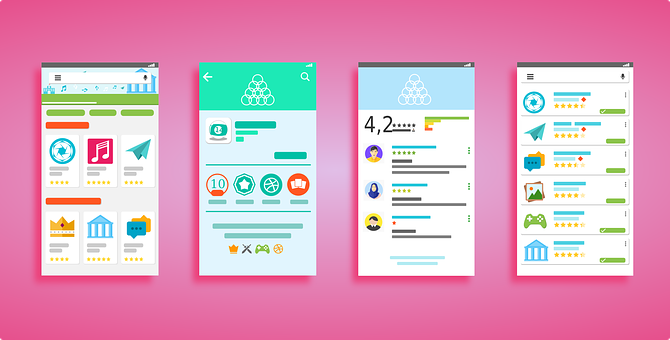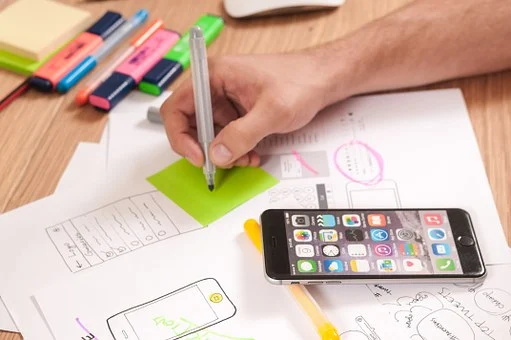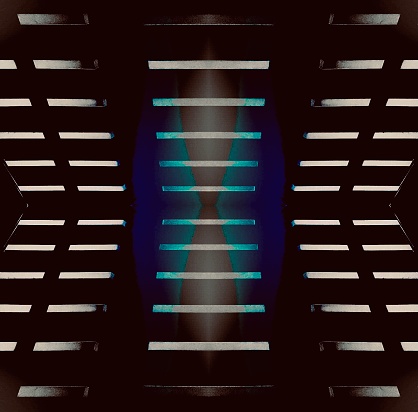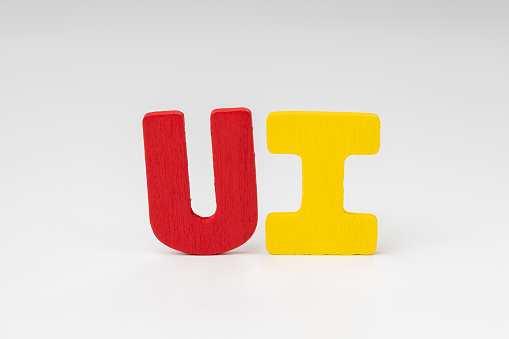
User Interface (UI) Design concentrates on predicting what purchasers may require to do and guaranteeing that the interface has features that are straightforward to enter, comprehend, and utilise to promote those actions. UI brings jointly visions from interaction design, visual design, and information architecture.
Selecting Interface Elements
Purchasers have become acquainted with interface elements acting in a particular way, so try to be constant and certain in your preferences and their layout. Doing so will help with task fulfilment, ability, and happiness.
Interface elements include but are not restricted to:
- Infusion Controls: buttons, text fields, checkboxes, radio buttons, dropdown lists, list boxes, toggles, date field
- Navigational Elements: breadcrumb, slider, search field, pagination, slider, tags, icons
- Informational Elements: tooltips, icons, progress bar, notifications, message boxes, modal windows
- Receptacles: accordion

There are moments when numerous aspects may be suitable for portraying content. When this occurs, it’s necessary to evaluate the trade-offs. For instance, sometimes aspects that can help save you space, but more of a limitation on the purchaser mentally by pushing them to assume what is within the dropdown or what the segment may be.
Best Practices for Creating an Interface
Everything originates from knowing your users, including comprehending their objectives, aptitudes, preferences, and preferences. Once you know about your purchaser, make sure to regard the following when creating your interface:
- Keep the interface straightforward. The best interfaces are almost imperceptible to the purchaser. They bypass excessive components and are evident in the language they use on tags and in messaging.
- Create viscosity and utilise familiar UI features. By utilising standard features in your UI, purchasers feel more relaxed and are capable to get things accomplished faster. It is also essential to form practices in language, layout and design throughout the site to help promote ability. Once a purchaser understands how to do something, they should be capable to transmit that skill to other territories of the site.
- Be intentional in page format. Regarding the dimensional relationships between objects on the page and the structure the page established on preference. A detailed sequence of items can help attract attention to the most essential pieces of information and can assist in browsing and readability.
- Importantly utilise colour and texture. You can handle attention toward or divert attention away from entities using colour, light, contrast, and texture to your benefit.
- Use composition to construct ranking and translucency. Carefully evaluate how you utilise the typeface. Diverse sizes, fonts, and arrangements of the text to help enhance scanability, accuracy and readability.
- Make sure that the strategy expresses what’s occurring. Always notify your purchasers of the zone, activities, differences in the state, or mistakes. The usage of diverse UI components to express rate and, if required, the next stages can ease frustration for your purchaser.
- Think about the insolvencies. By carefully considering and predicting the plans people bring to your site, you can form insolvencies that ease the limitation on the purchaser. This becomes especially essential when it comes to creating a system where you may have the opportunity to have some areas pre-chosen or sufficed out.

Standard UI Design Errors
The top five most standard UI design mistakes are:
- UI designers have evolved into becoming rule-smitten.
- The grid is limiting the inventive method of UI designers.
- UI design has been normalised with designs.
- Typefaces are terribly misconstrued.
- The disparity is not a strategy cure-all.
UI Designers Have Evolved Into Becoming Rule-Smitten

The world of graphic design has always obeyed sets of regulations and measures. Within design professions, ordinary mistakes overlap with a typical rule that has been violated. From this standpoint, design traditions seem to be responsible principles.
However, in every design profession (including app designers in the UK) , new tendencies and innovative creations have happened from intentionally violating regulations. This is feasible because the technique is dependent and needs designer preference. Design is not a function with finite solutions. Thus, design practices should be regarded as procedures rather than cold, hard facts. The professional designer knows and appreciates the rule book just adequately to be capable to break out of the box.
The way design is read online often circles around lists of dos and don’ts. Unfortunately, design requires a much more powerful understanding of guides and preferences. The path to good design does not run through frequent compliance to checklists.
Interestingly, if designers stop disobeying rules, then no innovative breakthroughs can be made. If UI designers only acquire the capability to follow guidelines rather than filing their judgment-making capabilities, they may quickly become outside. How else will we argue that our work adds more significant importance than off-the-shelf templates?
Be Cautious Of “Top 10” Design Rules
The problem with design rules in today’s world of UI design is their quantity. If designers need to solve problems, they can simply look to the existing UI community and their set of answers. However, the abundance of these principles and practices undermines their integrity.
A Google search for “Top UI Design Mistakes” generates a half million results. What are the chances that most, if any, of these authors agree with one another? What is the probability that each design tip presented exactly overlaps with the design situations of a reader?
Usually, online educational reports examine critical situations rather than the guiding design regulations behind a problem. The result is that new designers never understand why a design works the way it does. Rather, they become conditional on what has come before. Isn’t it a situation in that so few of these reports inspire design investigation or play?
Designers should draw on a toolkit of teaching regulations rather than a book of prearranged rules and design templates. “Press x for parallax scrolling and y for carousels. Before deciding, refer to the most recent blog post on which seafaring tool is trending.” B-o-r-i-n-g-!
Tips and “Top 10” Lists Follow Certain Movements
Crazes are like junk food for designers. Observing them delivers cheap answers that offer some initial payback but little significance over the long haul. Trend-following designers date themselves fast. The bonus for following somebody else’s design path? A gnawing sense of experienced void.
It’s true that operating to invent your own styles and methods is hard work, but it’s definitely worth the exertion. The daily improvements and breakthroughs are all your own. There’s something about copying that never appears to feed the designer’s core.
The Grid Is Limiting the Inventive Methods of UI Designers
It’s unthinkable for a UI designer to work without a grid. Web and mobile interfaces are essentially established on pixel-by-pixel association. There’s no way around it.
Nevertheless, this doesn’t mean that UI designers should only desire grid-basic impressions. Correspondingly, there’s no justification for all design-related conclusions to be founded on a grid.

Dodge Using the Grid as a Trendy Implement
Typically, designing in reaction to trends impacts poor design (especially for app designers in the UK) . At most useful, trends lead to sufficient results, but the general consequence is almost sure to be underwhelming. To be trendy is to be normal. Thus, when employing a grid in a design, comprehend what the grid has to offer as a mechanism and what it might signify. Grids typically define objectivity as everything within the limitations of a grid that appears identical.
Grids also qualify for an equitable seagoing adventure. Purchasers can leap from item to item without any interference from the designer’s curatorial hand. With other nautical structures, the designer might be able to group scope and establish selected successions more deliberately.
UI Design Has Been Normalised with Designs
The concept of normalized design essences foreshadows UI design. Architectural details have been recited and devoted to similar design cases for centuries. This approach makes sense for parts of a building that people rarely sense. Nevertheless, once architects normalised standard features like furniture measurements and handrail sizes, people began to voice disinterest in the beige physical circumstances that resulted.

Not only this but normalised measurements were proven to be futile. Based on statistical standards, they often forgot to serve large elements of the population. Repeatable elements have their place, but they should not be utilised casually.
Designers Shouldn’t Utilise Designs as Creations
Many UI designers regard designs as something more noticeable than a simple time-saving implement. They see them as off-the-shelf resolutions to complex design issues. Designs are planned to normalise frequent tasks and relics in order to make the designer’s job more straightforward. Acutely, particular practices like carousels, pagination, and F-patterns have become the fundamental layout of many of our interfaces.
Typefaces Are Terribly Misconstrued
Many “Quick Tips” configuration lists propose hard and fast regimes for fonts. Each rule is called faithfully, “One font family only! Monospaced fonts are dead! Dodge thin fonts at all costs!” This is nothing more than burning air.
The only honest limitations on type, text, and fonts centre on implementing legibility and getting suitable meaning. As long as the text is readable, there might be possibilities to utilise a variety of typefaces. The UI designer must take on the duty of knowing the history, employs, and design choices for each font enforced in an interface.
Typeface Clarity Dominates Supreme
Typefaces share meaning and impact clarity. With all of the controversy encompassing rules for clarity on devices, designers are overlooking that type is designed to invest in a body of text with a creative affection. Clarity is required, this isn’t to be denied, but it really should be an evident goal. The crucial thing to remember is that fonts are not just created for different backgrounds of clarity. They’re also important for communicating meaning and giving bodies of text subtle dispositions.
Bypassing Thin Fonts at all Costs is Foolish

Now that the direction has come reached, a standard structure objection supports bypassing thin fonts entirely.
Some designers are persuaded that thin fonts are unattainable to read or inconsistent between appliances. Honest moments. Nevertheless, this denotes a state in the present meeting of UI design where typefaces are only apprehended as a specialised choice linking to clarity. If clarity is the only design situation, why not dismiss thin fonts completely?
A more comprehensive method forms with familiarity with why a thin font may be profitable, and within what backgrounds. Bold, thick text is frankly much more challenging to read at distance than thinner text. However, as bold fonts carry more visible weight, they’re more suitable for headings or ranges with little text.
Thin fonts often operate serifs, making them appropriate for body text. How so? Serif characters flow together when viewed in rapid sequence, making them more relaxed for long periods of reading. Further, thin fonts are often selected because they obtain dignity. If a designer is employed to form an interface for a client whose declaration is visible refinement, it would be demanding to find a soberer typeface to do the assignment. This is something to think about when it comes web and mobile app development.
The Disparity Is Not a Strategy Cure-all
A standard thread that appears on many “Top Mistakes” lists facilitates UI designers to bypass low-contrast interfaces. It’s true that there are many examples in which low-contrast designs are undecipherable and impractical. Nevertheless, my worry, equivalent to my topics on thin fonts, is that the usage of fundamental language leads to comparable, high-contrast design civilisation.
Defaulting to High Disparity is Irresponsible
High disparity visuals are clearly compelling and stimulating. However, there are multiple states within the human dynamic range worth transferring. To be visibly stimulating might also be visibly safe (think about web and mobile app development for your design).
Take, for example, the entire enterprise of a contemporary sci-fi film. It appears as though every production has resorted to black and neon blue visuals as a way of deceiving onlookers into excitement. Would it not be more adequate to incorporate chronologies with both high and low disparity visions that encourage a wider scope of dynamic reactions?
Functionally, if every element in an interface is in high contrast to another, then nothing stands out. This defeats the potential value of contrast as a hierarchical tool. Considering different design moves as tools, rather than rules, is essential to avoiding the stagnant, trendy design.
Conclusion
At best, design rules are principles. They supply judgment-making protection and warn creators of the risks of reckless intentions. Contrarily, design rules are not regulations. They are not indestructible, and they are definitely not worthy of our unanimous surrender. In fact, design rules, when pursued carelessly, can evolve into severe crutches that cut our capacity to solve issues creatively.
Designers are not scientists. We aren’t secure to supply practical proof for every creative judgment we complete. It’s true that our work is one of strategy and intentional judgments, but there is room for intuition and creativity. In fact, our capacity to help our customers stand out in a chaotic world of modern content relies on our readiness to visualise new opportunities. We must test. We must recreate.
Design rules exist to be leveraged for visible benefit. They may be bent, even damaged, but they are never to be blindly observed. Smarty Studio can give you the guidance that you’ll need for future design development.

